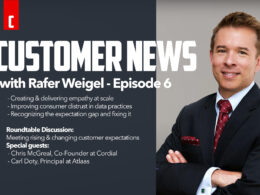“Brand engagement” is pretty straightforward – an Ideal for every product and service; it’s the yardstick consumers use to measure brands.
No matter how beautiful the Instagram post, you should occasionally look at the results. I said that. But I was paraphrasing Winston Churchill. He said, “However beautiful the strategy, you should occasionally look at the results.” He was right. Results are important. More than likes. Because no matter how much consumers liked/tweeted/shared the Larry David Super Bowl commercial, the brand should look at the results.
As “results” I’ll accept going to the site for the cryptocurrency exchange the ad was written for. I’ll even settle for your knowing the name of the company. Ah, ah, no cheating. No looking it up now. Even if you did you probably thought about googling “Larry David Super Bowl Commercial.” Yes, I know, you thought it was funny. You were entertained. You thought your cousins in New Jersey would get a kick out of it, so you shared it. Maybe even your Mom, even though she probably doesn’t know what crypto is, but you know she thinks Larry David is funny, so. . .
Or this. There’s a scene in the movie, The Intern, where someone at the office of an online clothing site rings a bell (they do that “when something good happens”) and says, “We just got 2,400 likes on our Instagram post.” The place goes wild. OK, it was a movie, but it’s a scene that you’ve probably seen in real life. Hell, you’ve probably participated in something like it.
I like the movie but as a former ad man and current brand guy that scene always bothers me. Shouldn’t they have waited for someone to say, “We just sold 2,400 of those periwinkle wrap dresses we posted on Instagram,” and then applaud wildly? Counting “likes” or tallying tweets or summing shares or measuring how entertained consumers were by a brand’s efforts aren’t really good enough. They’re not predictors of sales. They’re just self-fulfilling actions.
Entertainment is nice. Sometimes even beautiful. But engagement with the brand is the objective of the exercise. You want customers to come away from your advertising and marketing efforts thinking – feeling hopefully – that the brand better meets the expectation they hold for their category “Ideal.” Otherwise, all you end up doing is writing Saturday Night Live sketches or producing a very short, very expensive movies. There may be no business like show business, but it turns out there are several businesses like accounting. Just saying.
And yes, writing about advertising is always fun, if only to take another opportunity to remind our brand friends that advertising agencies are hired to actually sell something. And that it doesn’t really matter – beyond some bizarre ego-trip – how many “likes” their work racks up. Likes may salve creative self-images, but bottom-line, they’re not so good for sales. Creative that just gets seen – even liked – may be art, but it isn’t advertising.
Then there’s this. People don’t buy things they don’t like. Likes are pretty much a given. OK, there’s no empirical test for taste, but when you invite people to like you, a brand opens itself up to whatever their sense of taste or sense of humor is. And if consumers are just liking things for the sake of, well, just liking something, gee, that’s nice, I suppose, and it fills empty moments, but it kind of defeats the objective of selling something. You know, the “results” Mr. Churchill and I warned you about. Given marketing and advertising are businesses and not a hobbies.
And yes, the desire for approval, appreciation, and acceptance by others is a normal part of being human. As humans we’re hardwired to seek acceptance and avoid rejection, so the “liking space” makes us feel good. We all want to be liked. About ourselves. About brands. About stuff we buy. And, yeah, I know, in business, like life, likes are better than dislikes or thumbs down or whatever emoticon you’re relying on.
When it comes to ad playbooks (especially if you spend a gabillion dollars on production and a 60-second spot on the Super Bowl) brands look to score big in five ways: 1) big audiences, 2) big creative, 3) big buzz, 4) big social networking, and 5) big levels of emotional brand engagement. That last one is most important because it’s a leading-indicator of consumer behavior in the only arena that counts – the real-world marketplace.
Consumers need to be emotionally engaged with the ads so they come away feeling the brand better meets the expectations they hold for the category Ideal. Puppies are cute and all, but the ultimate question is what did the now-grown dog pining for the injured Clydesdale do for the Budweiser brand? Beyond collecting all those likes. Which do correlate with “entertainment” but not so much with sales.
Look, I understand that agencies and marketers hope their ads will entertain. That’s a dimension that’s easy to measure. And unquestionably advertising entertainment and social networking reviews generate lots of chatter. So, there you are. You managed to entertain 101 million Super Bowl viewers (assuming no one used the bathroom or went on a beer run when your ad ran). But these days that’s not enough. Or shouldn’t be.
“Brand engagement” is pretty straightforward. There’s an Ideal for every product and service; it’s the yardstick consumers use to measure brands. Defining your category’s Ideal is where it gets tricky. The process is more emotionally-based than rational, so defining the Ideal and identifying consumer expectations have to be more penetrating than the typical 10-point scale survey. Below-the-radar psychological metrics are what you need because today’s consumer does not behave as he or she says, does not say what he or she really thinks, and does not think what he or she feels.
A laugh or a like alone isn’t really an acceptable return on Super Bowl budgets. Or any budget, for that matter. Advertising should be judged not by entertainment ratings or likes, but how it ultimately helps the brand perform in the marketplace. Does the ad emotionally engage, build the brand’s equity and drive brand share, consumer behavior, and sales? If so, you’ll score positive bottom line impact, even if the advertising wasn’t as entertaining as envisioned. Not everyone can afford celebrities. But a brand that can both engage andentertain should get its own trophy. And sales, the ultimate award.
Given the Super Bowl was a couple of weeks ago, I’ll close with my annual thought that might be worth for all advertisers to remember: There is no “I” in “team,” but there sure is one in “Return-On-Investment.”
 Robert Passikoff is founder and CEO of Brand Keys. He has received several awards for market research innovation including the prestigious Gold Ogilvy Award and is the author of 3 marketing and branding books including the best-seller, Predicting Market Success. Robert is also a frequent contributor to TheCustomer.
Robert Passikoff is founder and CEO of Brand Keys. He has received several awards for market research innovation including the prestigious Gold Ogilvy Award and is the author of 3 marketing and branding books including the best-seller, Predicting Market Success. Robert is also a frequent contributor to TheCustomer.
Photo by Mika Baumeister on Unsplash.













2 comments